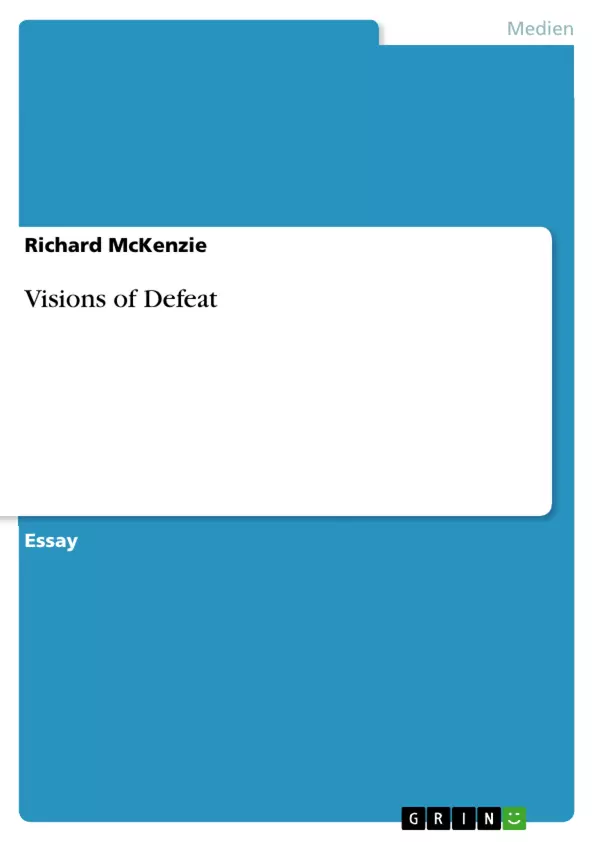At the end of World War II Germany’s cities were in ruins, its people shattered by 6 years of “Total War” and vilified as guilty monsters around the world. Curt Reiss, returned German émigré and American War Correspondent, described the streets of 1945 Berlin as “endless ruins, [...]bombed out tanks, the ubiquitous machine guns and helmets shot to pieces”. This fantastic landscape and guilty citizens fascinated filmmakers. They produced films which tried to depict the implications of defeat for Germany and for the victors. The backdrop to these films was the endless ruins and in the foreground the questions of guilt and redemption.
This essay examines three films which present Germany’s defeat, and how filmmakers dealt with questions of guilt, responsibility, Germany’s possible redemption and the affect of victory on Allied soldiers. The films are: Die Mörder sind unter uns, 1946, Wolfgang Staudte, Germany, DEFA, A Foreign Affair, 1948, Billy Wilder, US, Paramount , and The Third Man, 1949, Carol Reed, UK, London Films.
Elsaesser says that cinema describes its times calling it a “colourful chronotope, [which] provides an easily recognizable but also superficial time/space iconography” (Elsaesser, 2003, 33). Neorealism is suggested by Ezra as the main Post-War genre used to describe the destroyed cities, shattered lives and the difficulties of re-integrating former soldiers back in to society, saying “the privations suffered by populations of Europe were both captured and transformed into the first great genre to emerge at the end of the war, Italian Neorealism” (Ezra, 2004,9). It is clear however that in the films under discussion this is not the principle style used by Staudte, Wilder and Reed.
Inhaltsverzeichnis
- Introduction
- Die Mörder sind unter uns
- A Foreign Affair
- The Third Man
- Conclusion
- Bibliography
Zielsetzung und Themenschwerpunkte
Diese Abhandlung analysiert drei Filme, die die Niederlage Deutschlands im Zweiten Weltkrieg darstellen und untersucht, wie Filmemacher mit Fragen der Schuld, der Verantwortung, der möglichen Wiedergutmachung Deutschlands und der Auswirkungen des Sieges auf die alliierten Soldaten umgehen. Die Filme sind: Die Mörder sind unter uns (1946), A Foreign Affair (1948) und The Third Man (1949).
- Die Darstellung der deutschen Niederlage und die Auswirkungen auf die Gesellschaft
- Die Auseinandersetzung mit Schuld und Verantwortung
- Die Frage der Wiedergutmachung und des Wiederaufbaus
- Die Rolle der alliierten Besatzungsmächte
- Der Einfluss des Expressionismus auf die Filmdarstellung
Zusammenfassung der Kapitel
-
Introduction
Die Einleitung stellt die drei zu analysierenden Filme vor und beschreibt den historischen Kontext der Nachkriegszeit in Deutschland. Sie beleuchtet die zerstörten Städte, die psychischen Belastungen der Menschen und die Frage der Schuld und Wiedergutmachung. Der Essay untersucht, wie die Filmemacher mit diesen Themen umgehen und welche filmischen Mittel sie dafür einsetzen.
-
Die Mörder sind unter uns
Der Film Die Mörder sind unter uns zeigt die zerstörte Stadt Berlin und die psychischen Folgen des Krieges für die Menschen. Die Hauptfiguren, Susanne Wallner und Mertens, sind Opfer des Nationalsozialismus und versuchen, in der zerstörten Welt zurechtzufinden. Der Film beleuchtet die Frage der Schuld und der Verantwortung für die Verbrechen des Nationalsozialismus. Staudte verwendet expressionistische Elemente, um die zerstörte Welt und die psychischen Zustände der Figuren darzustellen. Die Ruinen Berlins werden zu einem Symbol für die innere Zerrissenheit der Menschen. Die Handlung des Films zeigt, wie Mertens mit Hilfe der Liebe von Wallner seine Vergangenheit aufarbeiten und seine innere Zerrissenheit überwinden kann.
-
A Foreign Affair
A Foreign Affair verlagert den Fokus von den Deutschen auf die amerikanischen Besatzungstruppen. Der Film zeigt, wie die Amerikaner mit der Denazifizierung Deutschlands umgehen und welche Probleme sie dabei haben. Die Hauptfigur, Pringle, ist ein amerikanischer Offizier, der sich in die deutsche Sängerin Erika von Schlütow verliebt. Der Film zeigt, wie die Amerikaner von der Korruption der deutschen Gesellschaft beeinflusst werden und dass die Denazifizierung nur oberflächlich ist. Die Geschichte von Erika von Schlütow zeigt, dass die Deutschen nicht bereit sind, sich ihrer Vergangenheit zu stellen. Wilder verwendet expressionistische Elemente, um die zerstörte Stadt Berlin und die moralische Verwirrung der Figuren darzustellen. Die Amerikaner werden in dem Film nicht als moralische Retter, sondern als Teil des Problems dargestellt.
-
The Third Man
The Third Man ist ein Film Noir, der die zerstörte Stadt Wien nach dem Krieg zeigt. Der Film zeigt, wie die Besatzungsmächte die Stadt kontrollieren und wie die Menschen in dieser dystopischen Welt leben. Die Hauptfiguren, Holly Martins und Harry Lime, sind in einen Schmuggelring mit Penicillin verwickelt. Der Film zeigt, wie die moralischen Grenzen verschwimmen und wie die Menschen in der zerstörten Welt versuchen, zu überleben. Der Film verwendet expressionistische Elemente, um die düstere Stimmung und die zerstörte Stadt Wien darzustellen. Die Handlung des Films zeigt, wie die Menschen durch die Folgen des Krieges moralisch verdorben werden und wie die dystopische Welt sie beherrscht.
Schlüsselwörter
Die Schlüsselwörter und Schwerpunktthemen des Textes umfassen die Niederlage Deutschlands im Zweiten Weltkrieg, die Auswirkungen des Krieges auf die Gesellschaft, die Frage der Schuld und Verantwortung, die Denazifizierung, die Wiedergutmachung, der Expressionismus im Film, die zerstörten Städte Berlin und Wien, die Besatzungsmächte, die moralische Korruption und die dystopische Welt der Nachkriegszeit.
- Citation du texte
- Richard McKenzie (Auteur), 2008, Visions of Defeat, Munich, GRIN Verlag, https://www.grin.com/document/178291



